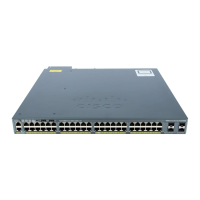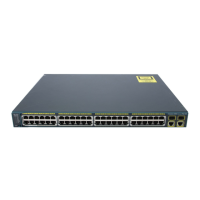Rapid Convergence
The RSTP provides for rapid recovery of connectivity following the failure of a switch, a switch port, or a
LAN. It provides rapid convergence for edge ports, new root ports, and ports connected through point-to-point
links as follows:
• Edge ports—If you configure a port as an edge port on an RSTP switch by using the spanning-tree
portfast interface configuration command, the edge port immediately transitions to the forwarding state.
An edge port is the same as a Port Fast-enabled port, and you should enable it only on ports that connect
to a single end station.
• Root ports—If the RSTP selects a new root port, it blocks the old root port and immediately transitions
the new root port to the forwarding state.
• Point-to-point links—If you connect a port to another port through a point-to-point link and the local
port becomes a designated port, it negotiates a rapid transition with the other port by using the
proposal-agreement handshake to ensure a loop-free topology.
Switch A is connected to Switch B through a point-to-point link, and all of the ports are in the blocking
state. Assume that the priority of Switch A is a smaller numerical value than the priority of Switch B.
Switch A sends a proposal message (a configuration BPDU with the proposal flag set) to Switch B,
proposing itself as the designated switch.
After receiving the proposal message, Switch B selects as its new root port the port from which the
proposal message was received, forces all nonedge ports to the blocking state, and sends an agreement
message (a BPDU with the agreement flag set) through its new root port.
After receiving Switch B’s agreement message, Switch A also immediately transitions its designated
port to the forwarding state. No loops in the network are formed because Switch B blocked all of its
nonedge ports and because there is a point-to-point link between Switches A and B.
When Switch C is connected to Switch B, a similar set of handshaking messages are exchanged. Switch
C selects the port connected to Switch B as its root port, and both ends immediately transition to the
forwarding state. With each iteration of this handshaking process, one more switch joins the active
topology. As the network converges, this proposal-agreement handshaking progresses from the root
toward the leaves of the spanning tree.
In a switch stack, the cross-stack rapid transition (CSRT) feature ensures that a stack member receives
acknowledgments from all stack members during the proposal-agreement handshaking before moving
the port to the forwarding state. CSRT is automatically enabled when the switch is in MST mode.
The switch learns the link type from the port duplex mode: a full-duplex port is considered to have a
point-to-point connection; a half-duplex port is considered to have a shared connection. You can override
the default setting that is controlled by the duplex setting by using the spanning-tree link-type interface
configuration command.
Catalyst 2960-XR Switch Layer 2 Configuration Guide, Cisco IOS Release 15.0(2)EX1
54 OL-29424-01
Configuring Multiple Spanning-Tree Protocol
RSTP Overview

